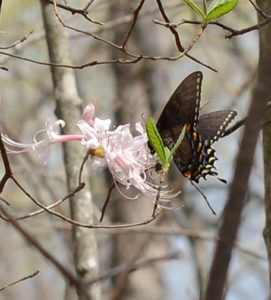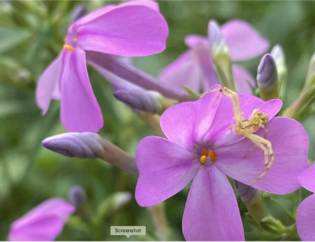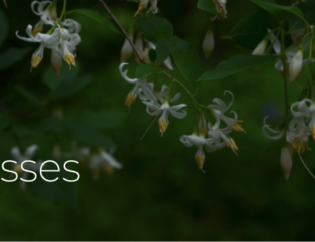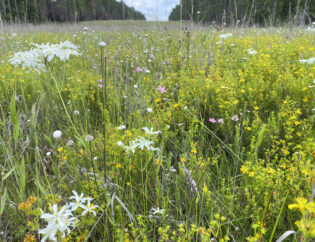
Every year there are a couple of azalea groves I love to visit in early spring. One is in the Boat Rock preserve in South Fulton County, and another is in the back acreage of our forest at Beech Hollow. And every year the groves are fireworks of flowers and Tiger Swallowtails.
The Tiger Swallowtails always seem to be one of the first butterflies to be up and out in the cool of early spring, and the azaleas are one of the few nectar sources available at the very beginning of spring. It is truly delightful to sit and watch the yellow winged males and the blue-black winged females delicately sip nectar all the while fanning their wings, slowly working their way across the azalea grove in loopy arcs. There are plenty of native bees visiting the flowers as well; they flit past the arched stamens and pistil to burrow down into the corolla and access the nectar. Those stamens and the pistil don’t come close to brushing the bees as they pass.
Here’s the thing: How would the bees pollinate the azaleas? The anthers and pistils flare out, well away from the nectar. Bees that access nectar alone won’t necessarily make contact with the stamens or pistil. In 2015, Mary Jane Epps, Suzanne E Allison, and Lorne M Wolfe published a paper about wing pollination by tiger swallowtails of Flame Azalea (Rhododendron calendulaceum) in the Blue Ridge. Very cool! Could our Piedmont Azaleas be pollinated in the same way?
Last spring, Jessi and I decided to take a look for ourselves in our grove of Piedmont Azalea (Rhododendron canescens) up by the boulders in the back of Beech Hollow. While we sat, a male Tiger Swallowtail was on patrol at the grove, waiting for a female. He looped around the grove, from flower to flower, fanning his wings as he nectared. He was such a pale yellow that it was hard to tell if he had gathered any pollen on his wings. Then a female swallowtail came by, and:


Above, on the left, female Tiger Swallowtail (Papilio glaucus) with her wings brushing the anthers of Piedmont Azalea. On the right, several minutes later, the same female with pollen visible on her wings.
This is an observation, not a scientific study. But it does appear that the same type of wing pollination that was recorded by scientific study in Flame Azaleas may also be occurring in Piedmont Azaleas.
That same spring at Boat Rock Preserve in Southwest Fulton County my husband Michael Williams was taking photos in the Piedmont Azaleas and caught this critter, a Hummingbird Clearwing moth, (possibly Hemaris thysbe) hard at work in the azalea flowers:

I wonder if this species is also capable of wing pollination?
Here is the citation for the 2015 article on wing pollination:
Epps, Mary Jane, Allison Suzanne E., and Wolfe, Lorne M. Reproduction in Flame Azalea (Rhododendron calendulaceum, Ericaceae): A Rare Case of Insect Wing Pollination. The American Naturalist, vol 186, No. 2. August 2015.









